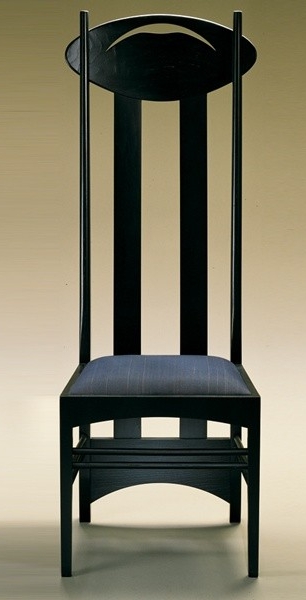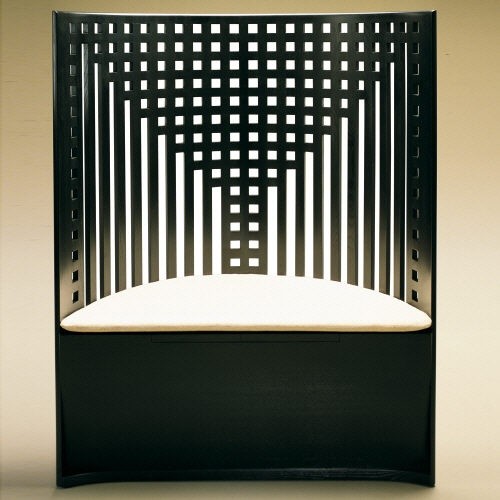
144th birthdays aren't occasions all celebrate; however, because Charles Rennie Mackintosh ties in so nicely with so many of the themes we've covered in the past weeks it seems like an occasion we can't ignore.
Born in Glasgow on June 7th 1868 Charles Rennie Mackintosh trained as an architect with John Hutchinson before moving to the larger company Honeyman & Keppie following his qualification in 1889.
In 1890 Mackintosh was given his first solo project, designing an extension for the back of the Glasgow Herald newspaper offices on Buchanan Street, a project that was quickly followed by contributions to the Martyrs' Public School and Queen Margaret's Medical College.
In 1896 Honeyman & Keppie were awarded the commission to build the new Glasgow School of Art: with a design largely developed by Mackintosh. Construction began in 1898 and a year later the doors opened on a building that remains not only one of the most genuinely interesting buildings in Glasgow, but one of the most instantly recognisable and finest examples of Mackintosh's architectural work.
1898 was also a significant year for Charles Rennie Mackintosh as it saw him complete his first commission for the soon to be legendary, Miss Cranston. At that time it was only a series of wall stencils, but over the next dozen years or so Mackintosh was to create interiors for all four of Miss Cranston's Glasgow tea rooms. A contract that not only saw him work as one of the first genuine interior designers, but also produced a range of furniture whose form and aesthetics continue to attract and bewitch. The Willow Chair and Argyle Chair being perhaps two of the best known examples.
It also created in the case of the Willow Tea Room a future tourist attraction that would provide American visitors with somewhere to shelter from the ubiquitous Glasgow rain before getting on the train back to Edinburgh.
In addition to tea rooms and art schools Charles Rennie Mackintosh was also responsible for various private houses, most famously Hill House in Helensburgh, where he not only created the fortress-esque building but was also responsible for the fixtures, fittings and decoration. The Hill House Chair remaining one of furniture designs most iconic pieces, while projects such as Hill House made Mackintosh one of the influences for the short-lived historical revival of 1950s UK design.

Beyond to his talents for architecture and design Charles Rennie Mackintosh was a prolific and skilled painter, and his later years were largely taken up with artistic endeavours.
Charles Rennie Mackintosh died in London in 1928.
While highly regarded and respected in the UK, as one of the leading lights in the Arts and Crafts movement Charles Rennie Mackintosh was also to have an influence that extended far outwith his native shores.
In 1903 one Hermann Muthesius, at the time Cultural Attaché at the German Embassy in London, published several articles in leading Germanophone newspapers of the day praising Mackintosh and the beauty of his work, in particular his tea rooms. Such praise obviously not going unnoticed by the burgeoning Jugendstil movement.
Following his return to Germany in 1904 Hermann Muthesius remained in close contact with Mackintosh, and as co-founder and later chairman of the Deutscher Werkbund movement had ample opportunity to further disseminate Mackintosh's ideas on the continent.
On a side note, Hermann Muthesius' continual arguments with Henry van de Velde and Walter Gropius more or less forced the split in the Werkbund that led to the establishment of Bauhaus. "No Mackintosh, No Bauhaus" is historically inaccurate. But an intriguing line of thought nonetheless.
The Dutch were also looking at what was happening on the other side of the German Ocean at the turn of the century and many elements of Mackintosh's work can be found in objects created by members of de Stijl movement. Indeed some of the precursor pieces leading up to Gerrit Rietveld's Rood blauwe stoel contain a form language and construction technique that demonstrate uncanny parallels to what Miss Cranston's guests were sitting on as they enjoyed their tea and scones.
Mies van der Rohe allegedly once said that Charles Rennie Mackintosh "tidied up architecture". That may be, what is unquestionable is that through his development of an approach that reduced objects down to a minimum, without losing sight of decorative elements, Charles Rennie Mackintosh helped accelerate the move away from Historicism and so created an environment receptive to Modernism. Which is in our humble opinion is a decent contribution to contemporary architecture and design.
Happy Birthday Charles Rennie Mackintosh!
